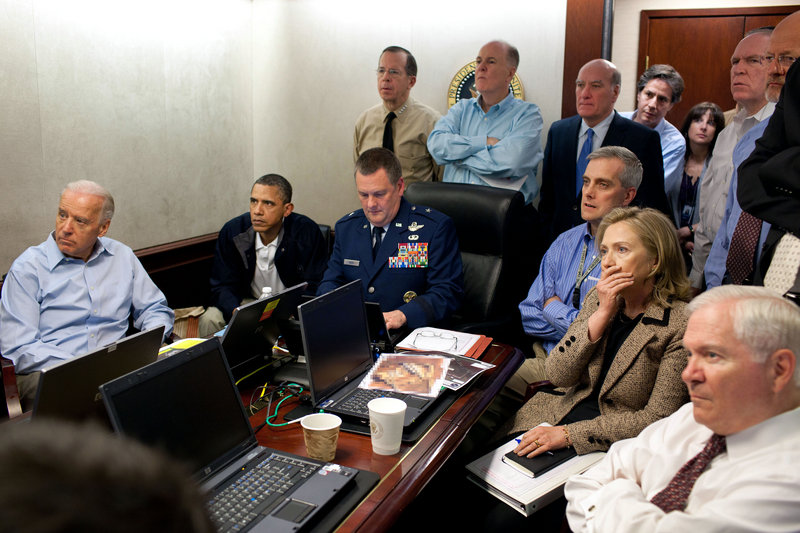WASHINGTON – Taut and riveting, the photo takes the world inside history: Around a lacquered table in the Situation Room, the president and his team are watching a heart-pounding hunt for a killer, Osama bin Laden.
President Obama leans forward, deadly serious. Secretary of State Hillary Rodham Clinton holds her right hand over her mouth, a worried look on her face.
Vice President Joe Biden and Defense Secretary Robert Gates stare stone-faced. So do the chairman of the Joint Chiefs of Staff, the national security adviser and the White House chief of staff.
So what exactly were they watching on that video screen?
What’s clear is that Obama viewed and listened to updates by the minute on the mission to get bin Laden in his secure compound in Pakistan.
It appears the president would have been able to see one of two U.S. helicopters fall and land hard inside the compound just as the SEALs started sliding down the rope, indicating that the risky mission was not going as planned.
Obama was getting the same feed as the one being piped into an operations center at CIA headquarters, an aerial view of the compound. A U.S. official described the tense moments at Langley of the hard helicopter landing, speaking on condition of anonymity to discuss the classified operation.
CIA Director Leon Panetta said the president and his team were not getting a direct video feed of the floor-by-floor raid as U.S. commandos searched for, found and killed bin Laden.
Obama never saw the moment when bin Laden was shot dead.
In fact, the tension in the Situation Room was caused largely by the agonizing wait that the president and his team had to endure before learning just what was happening.
“Once those teams went into the compound, I can tell you, there was a time period of almost 20 or 25 minutes where we really didn’t know exactly what was going on,” Panetta told PBS. “And there were some very tense moments as we were waiting for information.”
The White House refuses to say exactly what was happening in the moment captured by Pete Souza, the chief official White House photographer for Obama. Officials said revealing details could disclose sensitive information about how such operations are run.
“The president and his top national security aides in the Situation Room had available to them minute-by-minute updates on the operation, and that photograph was taken during the operation,” Obama spokesman Jay Carney said. “I can’t get more specific than that.”
The split screens allowed for Obama to get accounts from different locations.
Military leaders were in the Pentagon, in the National Military Command Center, monitoring the operation. From there, Gen. James Cartwright, vice chairman of the Joint Chiefs of Staff, communicated with those in the Situation Room via videoconference as the operation progressed, providing updates and seeking decisions from the president when needed.
Meanwhile, Panetta was at the CIA, and his image was also piped up on the screen in the Situation Room.
Panetta was overseeing the mission and was in touch with the one who commanded it on site, Adm. William McRaven, head of the Joint Special Forces Command.
One video feed came from aerial surveillance of the compound from above. There was also a video feed from some of the commandos’ helmets, though it was not clear that officials at the CIA and the White House could see the helmet cameras as well.
After the tense 20 or 25 minutes, McRaven reported back that commandos had bin Laden.
Regardless of the details, the photo from the Situation Room drew intense reactions.
“It demonstrates the intensity and emotion for the nation’s key leaders, who carry the burden of these decisions,” said Juan Zarate, a top White House counterterrorism official under President George W. Bush and now a senior adviser at the Center for Strategic and International Studies. “This was a very risky operation. And the risk is evident in the eyes of the president and the gestures of the secretary of state.”
Send questions/comments to the editors.



Success. Please wait for the page to reload. If the page does not reload within 5 seconds, please refresh the page.
Enter your email and password to access comments.
Hi, to comment on stories you must . This profile is in addition to your subscription and website login.
Already have a commenting profile? .
Invalid username/password.
Please check your email to confirm and complete your registration.
Only subscribers are eligible to post comments. Please subscribe or login first for digital access. Here’s why.
Use the form below to reset your password. When you've submitted your account email, we will send an email with a reset code.